|
|
|
The Green Mamba - June 2023
The Green Mamba (Dendroaspis angusticeps) was described by Sir Andrew Smith in 1849 from animals collected from Natal.
The Latin name angusticeps comes from “angustus” meaning narrow and “ceps” an abbreviation for head – narrow head. Surprisingly, many years back the Black and Green Mamba were considered to be the same species and were thought of as colour variations. Some theories included that young mambas were green, turning darker and almost black as they age. Another theory being that males were black and females green or that mambas that lived in the sun turned dark and those in thick coastal forests and didn’t see much sun stayed green. It wasn’t until 1946 when the Fitzsimons brothers noted the differences between the two species and revived Günther’s 1846 name Dendroaspis polylepis (many-scales) for the Black Mamba and kept Dendroaspis angusticeps for the Green Mamba.
|
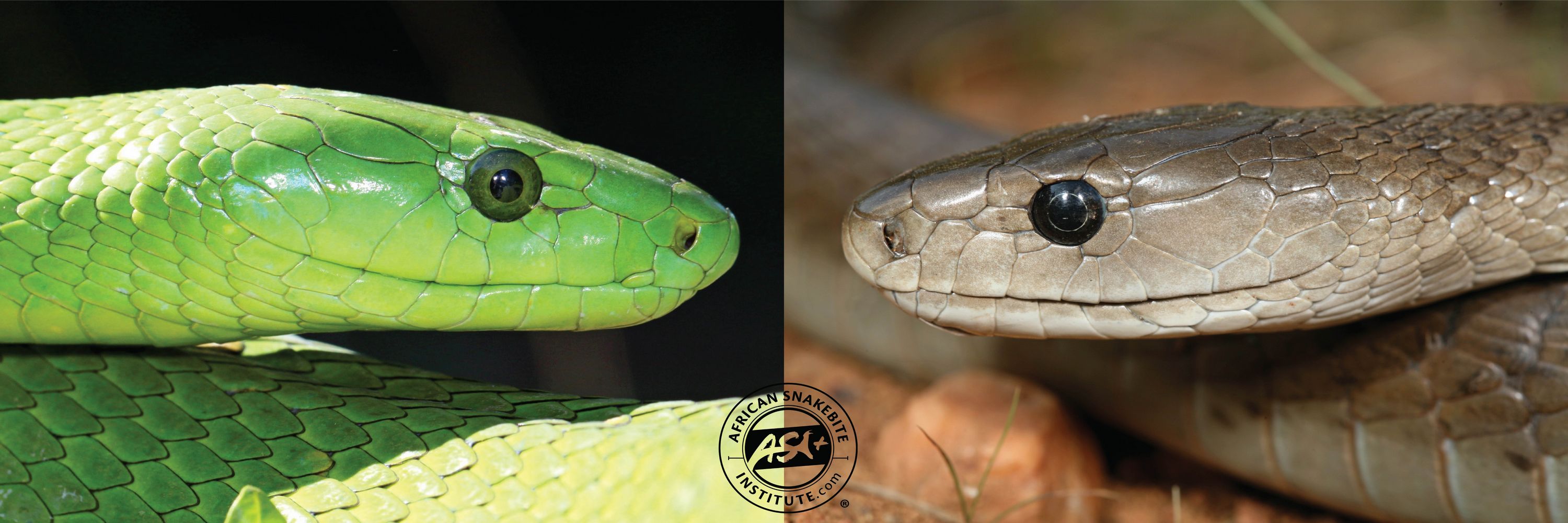 |
|
Green Mamba left vs Black Mamba right. Green Mambas usually have 19 midbody scale rows whereas Black Mambas have 23-25.
|
|
|
|
ASI Venom tee now in stock!
The newest ASI T-shirt to hit the shelves! Available in sizes extra small to 3XL.
Price R200.00
|
| Order here |
|
|
|
The Green mamba is an attractive bright green snake, with velvety scales and may have scattered yellow scales across the body. The underside is light green to yellowish. Juveniles are often darker turquoise with green heads and light olive-green eyes. As is the case with most green pigments in nature, damaged scales or dead green mambas will start turning blue and there are infrequent reports of blue Green Mambas. The maximum length of a Green Mamba is around 2.5 meters although they are seldom encountered over 2m. Juveniles hatch at around 30-40 cm and grow rapidly.
|
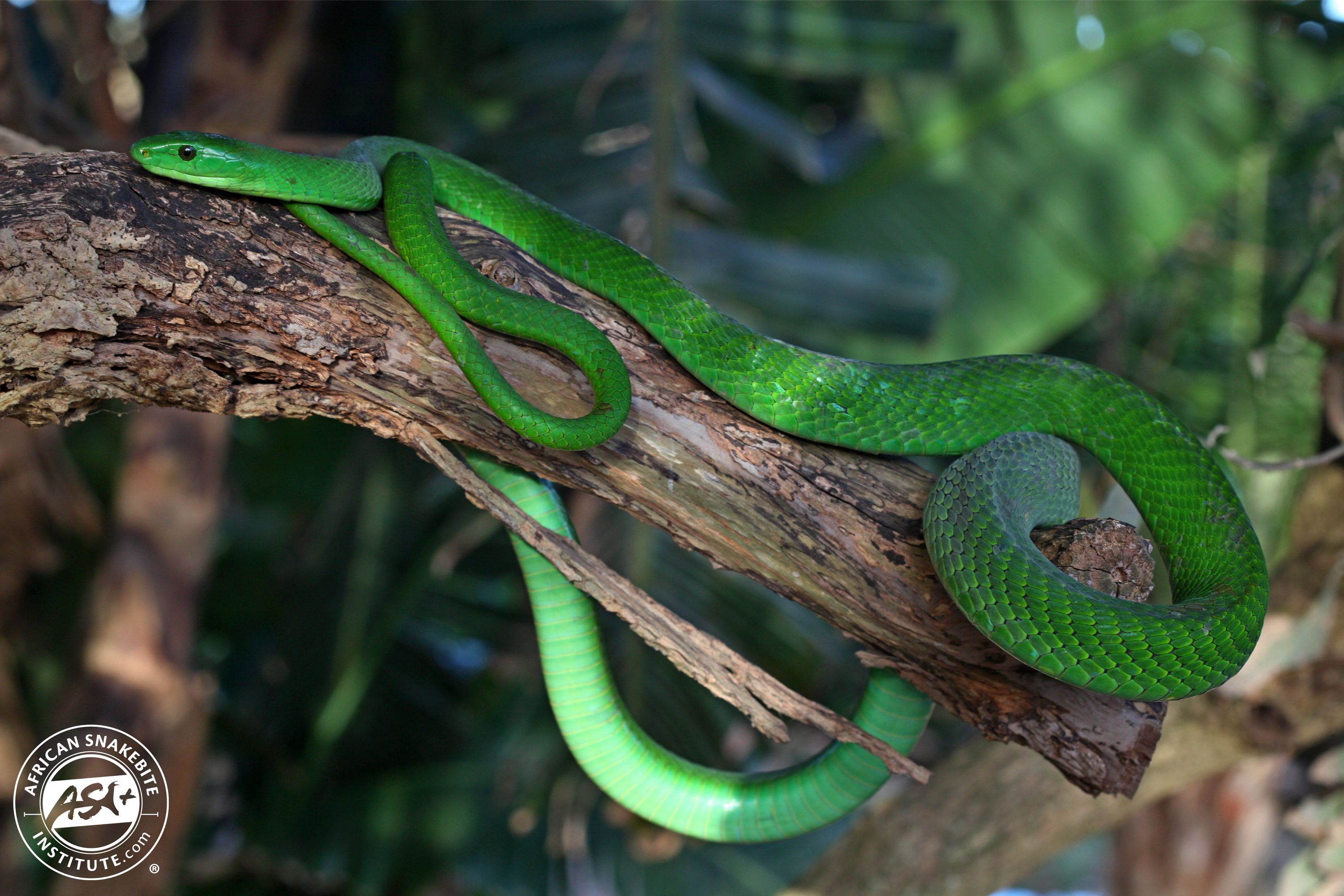 |
|
Green Mambas are bulky green snakes with velvety scales and a green belly.
|
|
|
|
Snake Tongs
Looking for quality Snake Handling Equipment?
We stock over 15 different sizes and types of quality snake tongs.
Check out the widest range of quality snake handling equipment in Africa.
|
| View tongs online here |
|
|
|
Green Mambas are known to engage in male combat at the start of the breeding season. From around April we start seeing males engaged in combat, usually on the ground, wrapped around one another with their heads in the air, attempting to push the other males head down and show dominance. The dominant male will then move off and mate with the female who will be nearby. Mating takes place from April to June and is usually performed in a tree with tails of the two snakes hanging down and lightly wrapped around one another. The female lays eggs in midsummer and the babies hatch between March and April.
This is a docile snake and is not nearly as nervous and unpredictable as the Black Mamba. It seldom gapes the mouth in a threat display and prefers to move off into thick vegetation if disturbed. It is an arboreal (tree-living) snake, only venturing to the ground to move between trees, bask in a sunny spot or chase prey. At night they may sleep curled up on branches or in the hollow of a dead tree stump. They prey largely on birds and small rodents and occasionally chameleons.
|
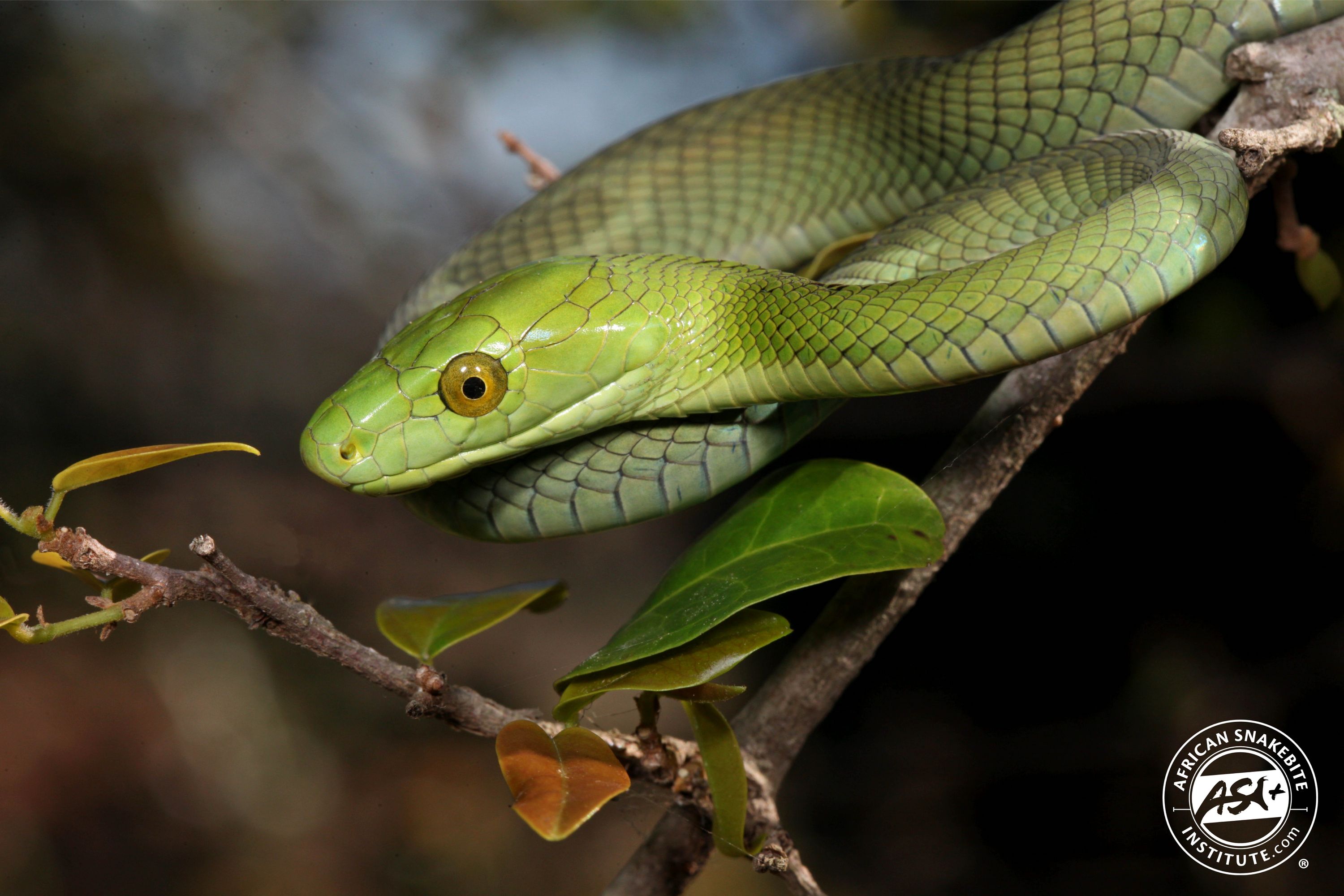 |
|
Juvenile Green Mambas hatch around March-April and are olive to turquoise, usually with a lighter green head and large olive eye.
|
|
|
|
Green Mambas are an east coast species, occurring from around Port St Johns in the Eastern Cape along the coast into KwaZulu-Natal eastward into Mozambique and north into East Africa. In South Africa they are usually found within 3-5 km from the sea, but into northern KwaZulu-Natal they may extend inland as far as 45 km. In Mozambique they largely hug the coast but do extend inland around Vilankulos and extend into the thick forests around the Zimbabwean Eastern Highlands. They are also known inland in Malawi but stay coastal in Tanzania and Kenya. This snake prefers tropical climates of coastal forest or moist savanna and savanna forest. It is not found in dry lowveld habitat such as the Kruger National Park, eSwatini or Zambia and many people mistake the Boomslang or a selection of harmless green snakes in the genus Philothamnus for the Green Mamba.
|
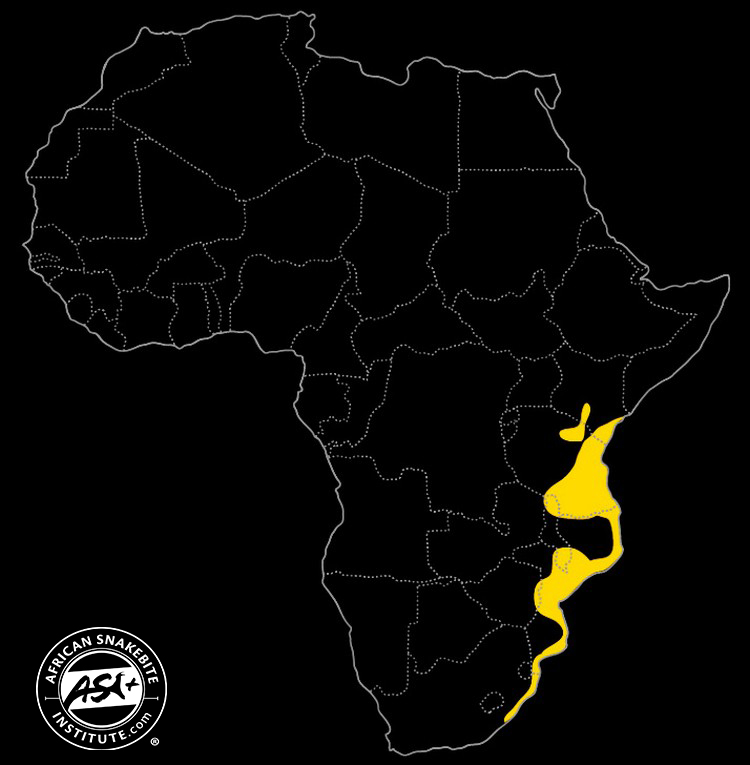 |
|
Distribution map of Green Mambas in Africa.
|
|
|
|
A Complete Guide to the Snakes of Southern Africa.
The long-awaited third edition of A Complete Guide to the Snakes of Southern Africa has been updated, revised and expanded.
New information based on scientific research relating to behaviour, identification, reproduction and snake venoms has been included in the species accounts. This book covers all essential aspects of snake biology and behaviour. Species descriptions are accompanied by full-colour photographs and distribution maps. Chapters on classification and identification, keeping snakes, and the treatment of snakebite supplement the species accounts.
Price R450.00
|
| Order here |
|
|
|
The venom is considered potentially lethal and is known to have some neurotoxic properties that may affect breathing. However, recent bites have all shown decent swelling and limited neurotoxic effects, suggesting the venom is a mix of neurotoxic and cytotoxic proteins. As this snake is docile, it is unlikely that the average person would get bitten. However, in the event of a bite, the victim should be taken to the hospital immediately. Fatal bites from the Green Mamba are rare.
This is a beautiful, docile snake that poses little danger to the average person. They are best left alone and admired. However, if a Green Mamba does end up in your house or garden and poses a threat to humans or pets, use the ASI Snakes App to find a nearby snake remover and get the snake relocated to a safer area.
|
 |
|
Green Mambas are easily confused with the Boomslang or a selection of other harmless green snakes. With some experience, you can tell these snakes apart based on head profile, eye colour and distribution. You can read more on the identification of green snakes here.
|
|
|
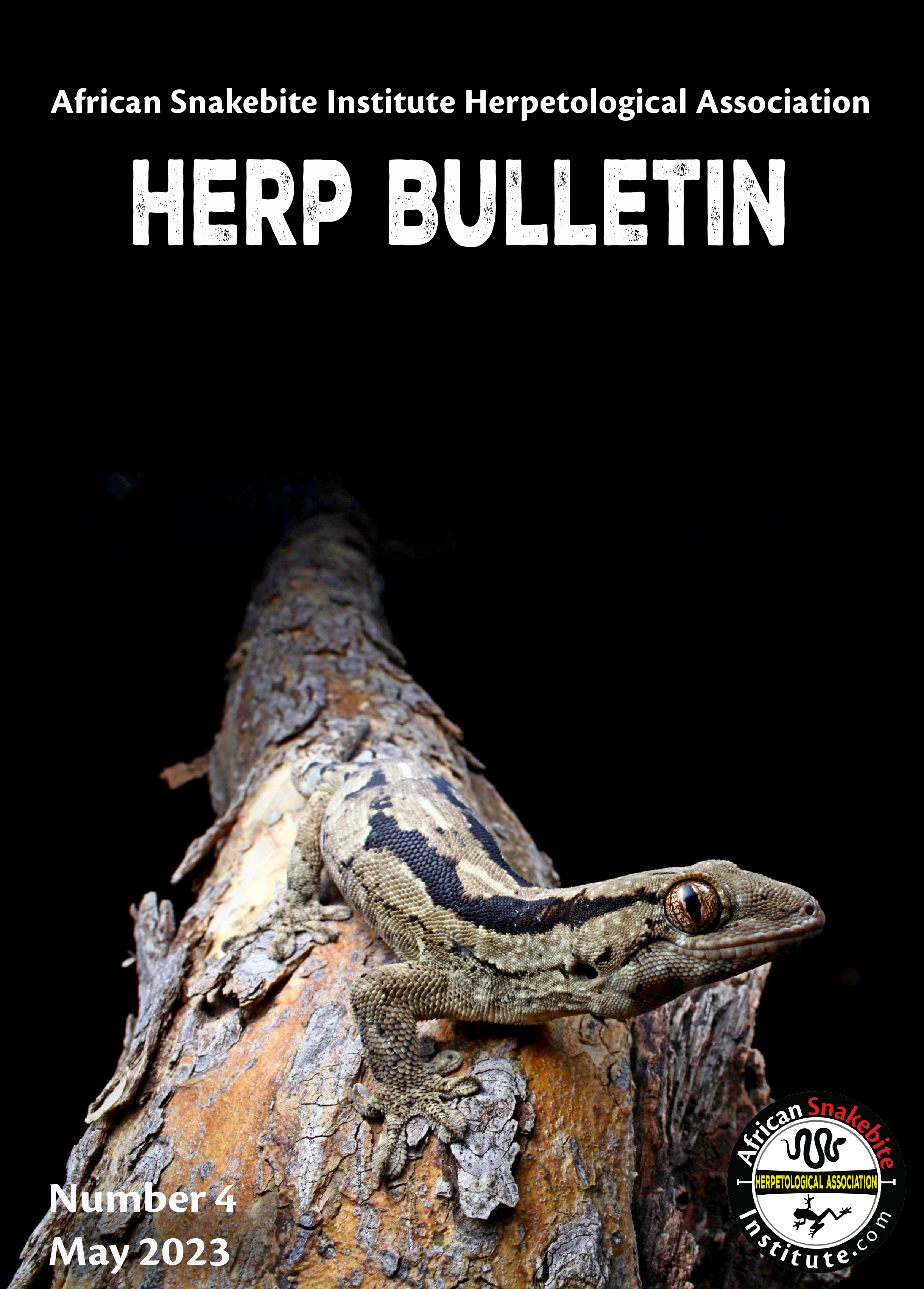 |
|
If you have a general interest in reptiles and amphibians, have a look at the newest edition of the ASIHA Herp Bulletin. This edition covers topics from keeping House Snakes to diets of Boomslang, Cobra bites and herp adventures. You can read the free publication here.
|
|
|
|
Battling to make it to one of our in-person courses? Sign up for our Online Snake Awareness and First aid for Snakebite courses here.
|
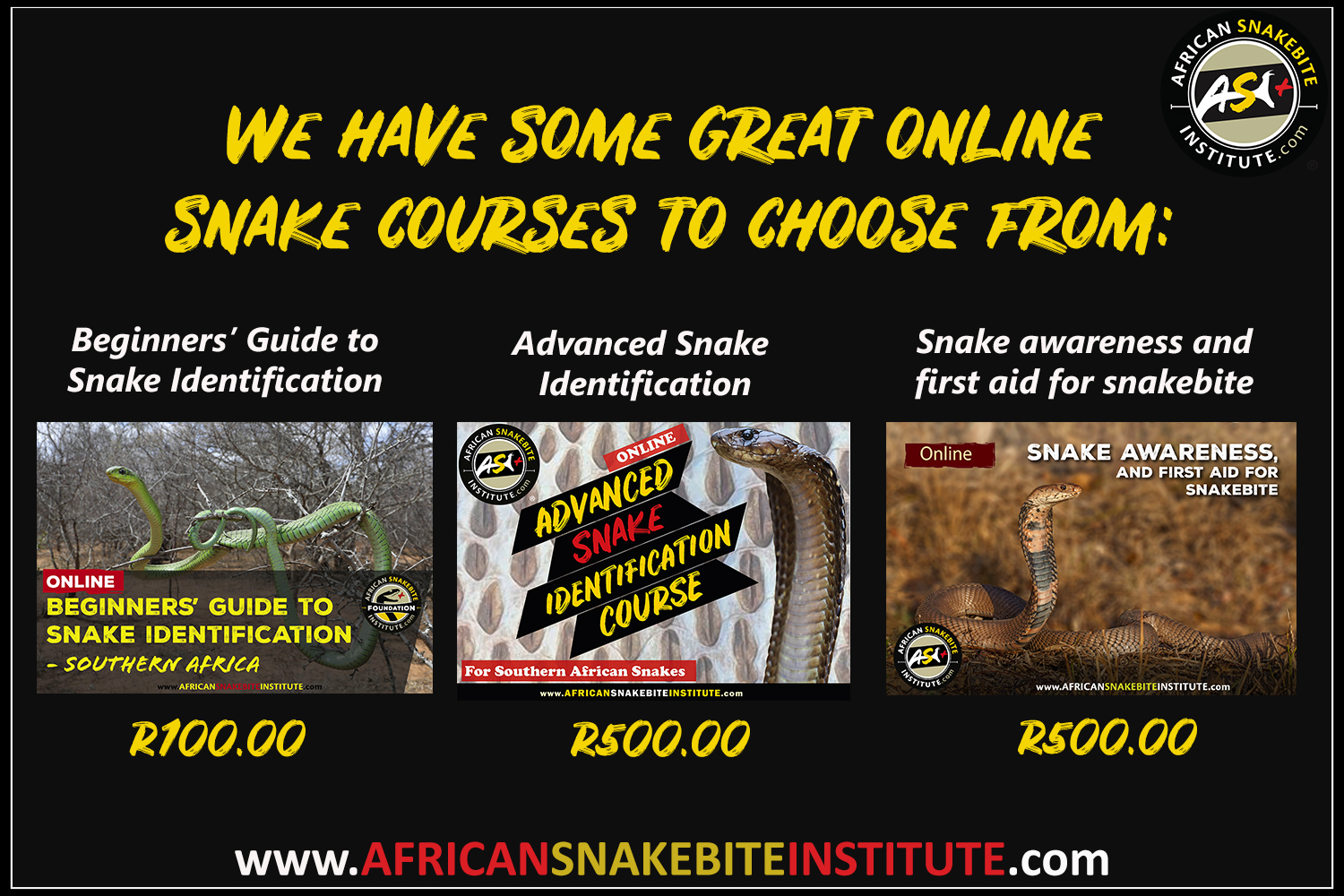 |
|
|
 |
|
|
|
GAUTENG
Snake Awareness, First Aid for Snakebite and Venomous Snake Handling Course
Date: Saturday 24 June 2023
Venue: Cradle Moon Lakeside Lodge, Muldersdrift, Gauteng
|
|
|
| Book here |
|
|
|
GAUTENG
Venomous Snake Handling Bootcamp
Date: Sunday 25 June 2023
Venue: Cradle Moon Lakeside Lodge, Muldersdrift, Gauteng
|
|
|
| Book here |
|
|
|
|
|
WESTERN CAPE
Snake Awareness, First Aid for Snakebite and Venomous Snake Handling Course
Date: Saturday 24 June 2023
Venue: Exotic Animal World, Klapmuts, Western Cape
|
|
|
| Book here |
|
|
|
|
|
WESTERN CAPE
Venomous Snake Handling Bootcamp
Date: Sunday 25 June 2023
Venue: Exotic Animal World, Klapmuts, Western Cape
|
|
|
| Book here |
|
|
|
FREE STATE
BLOEMFONTEIN
Snake Awareness, First Aid for Snakebite and Venomous Snake Handling Course
Date: Saturday 01 July 2023
Venue: Hellenic Community Hall, Bloemfontein, Free State
|
|
|
| Book here |
|
|
|
FREE STATE
BLOEMFONTEIN
Venomous Snake Handling Bootcamp
Date: Sunday 02 July 2023
Venue: Hellenic Community Hall, Bloemfontein, Free State
|
|
|
| Book here |
|
|
|
LIMPOPO
HOEDSPRUIT
Snake Awareness, First Aid for Snakebite and Venomous Snake Handling Course
Date: Saturday 08 July 2023
Venue: Southern Cross Schools, Hoedspruit, Limpopo
|
|
|
| Book here |
|
|
|
LIMPOPO
HOEDSPRUIT
Venomous Snake Handling Bootcamp
Date: Sunday 09 July 2023
Venue: Southern Cross Schools, Hoedspruit, Limpopo
|
|
|
| Book here |
|
|
|
|
|
|
|
Johan Marais is the author of various books on reptiles including the best-seller A Complete Guide to Snakes of Southern Africa. He is a popular public speaker and offers a variety of courses including Snake Awareness, Scorpion Awareness and Venomous Snake Handling. Johan is accredited by the International Society of Zoological Sciences (ISZS) and is a FGASA (Field Guides Association of Southern Africa) and SASTM (South African Society of Travel Medicine)-approved service provider. His courses are also accredited by the HPCSA (Health Professions Council of South Africa). Johan is a qualified instructor for the Emergency Care & Safety Institute in Oxygen Administration and Wilderness First Aid and a qualified Basic Life Support instructor.
|
 |
|
Copyright © 2023 African Snakebite Institute, All rights reserved.
Our mailing address is:
admin@asiorg.co.za
Unsubscribe from this list
|
|
|